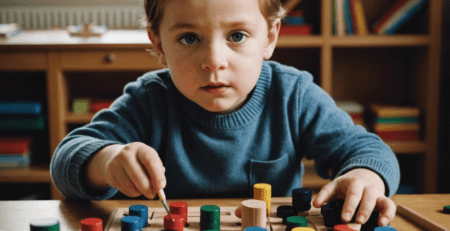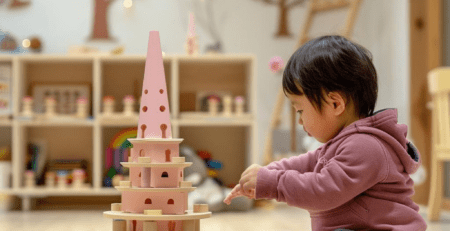
21
Parallel Play: Exploring the Benefits and Techniques for Child Development
Parallel play, the seemingly independent and solitary activity favored by young children, is an intriguing behavior that can shed light on their development and social skills. While it may appear as if children are simply playing alongside each other without interaction, this form of play actually holds valuable insights into their cognitive and emotional development. Let’s delve into the world of parallel play to explore its significance in the lives of young children.
Table of Contents
- What is Parallel Play?
- The Benefits of Parallel Play
- Types of Parallel Play
- Challenges of Parallel Play
- Tips for Encouraging Parallel Play
- Supporting Healthy Development through Parallel Play
- Q&A
- To Conclude
What is Parallel Play?
Parallel play is a term used in child psychology to describe a type of play in which children engage in similar activities, but do not actively interact with each other. Instead, they play alongside each other, often mimicking each other’s actions, but without direct engagement or collaboration. This type of play is commonly observed in toddlers and young children, and it is considered a normal stage of social development.
During parallel play, children may be in close proximity to each other, using similar toys or participating in similar activities, but they do not engage in conversation or cooperative play. This type of play allows children to learn from and observe each other, develop social skills, and gain a sense of independence and autonomy. It is an important stage in a child’s social development as they learn to navigate social situations, understand the boundaries of their own space, and observe the actions of their peers.
Parallel play is typically seen in children between the ages of 2 and 3, and as they grow older, they begin to engage in more interactive and cooperative play with their peers. While it may appear as if children are simply playing independently, parallel play actually lays the foundation for future social interactions and is an essential part of a child’s social and emotional development.
The Benefits of Parallel Play
Parallel play refers to the type of play in which children play near each other, but not with each other. This type of play allows children to engage in their own activities while also observing and mimicking the behaviors of other children. Although it may seem like they are not interacting, parallel play actually offers a wide range of benefits for children’s social, emotional, and cognitive development.
Benefits of Parallel Play:
- Social Development: Parallel play provides children with the opportunity to learn how to be around others and develop their social skills without the pressure of direct interaction.
- Imagination and Creativity: Children engaged in parallel play often use their imagination and creativity to come up with their own play scenarios and storylines, fostering their cognitive development.
- Independence and Confidence: By engaging in play on their own terms, children develop a sense of independence and confidence in their abilities.
- Observational Learning: Parallel play allows children to observe and learn from others, leading to the development of important social and behavioral skills.
Types of Parallel Play
Parallel play is a common behavior in children, especially in the early stages of social development. It is a type of play where children play near each other, but not necessarily with each other. This type of play allows children to engage in independent play while still being in the presence of others. There are several that children may engage in:
1. Onlooker Play
This type of parallel play occurs when a child watches others play without actively participating. The child may be curious about the play activities of others and may learn by observing, but they do not join in the play themselves.
2. Solitary Play
During solitary play, children play alone without any interaction with other children. They may be engaged in their own activities, toys, or games and show no interest in engaging with others.
3. Spectator Play
Spectator play involves watching other children play and occasionally making comments or asking questions, but without actively participating in the play. The child may show interest in what others are doing, but prefer to stay on the sidelines.
Understanding the different can help parents and caregivers support children’s social development and encourage healthy interactions with others.
Challenges of Parallel Play
Parallel play, a stage of play where children play near each other but not together, may seem simple on the surface, but it comes with its own set of challenges. Understanding and addressing these challenges can help parents and caregivers better support children in this important stage of development.
1. Lack of Social Interaction: One of the main is the lack of direct interaction between children. While they may be in close proximity, they are not actively engaging with each other, which can hinder the development of important social skills such as sharing, taking turns, and empathy.
2. Misunderstood Behavior: Sometimes, adults may misunderstand parallel play as a sign of shyness or a lack of interest in playing with other children. This misunderstanding can lead to unnecessary pressure on the child to engage in more interactive play before they are ready, which can be counterproductive to their developmental needs.
3. Peer Conflict: In a parallel play setting, conflicts between children can arise without direct adult intervention. These conflicts may be subtle, such as one child encroaching on another’s play space, but they can still impact the children’s ability to play independently and peacefully.
Tips for Encouraging Parallel Play
Parallel play is a crucial stage of social development for young children, where they play alongside each other without directly interacting. Here are some tips to encourage and support parallel play in children:
Set the Stage
Create a stimulating environment that promotes parallel play, such as setting up a playdate with peers or providing open-ended toys like blocks and dollhouses. Encourage children to engage in independent play by offering a variety of activities and materials to explore.
Lead by Example
Demonstrate parallel play behavior by engaging in your own activities alongside your child. This will show them how to play independently and model the behavior you want to encourage. Be present and available, but allow your child the freedom to explore and play on their own terms.
Be Patient and Supportive
Give children the time and space they need to feel comfortable playing independently. Avoid forcing interaction or interrupting their play, as this can disrupt the flow of parallel play. Offer praise and positive reinforcement when you notice your child engaging in parallel play, and provide gentle guidance if they seem hesitant or unsure.
Supporting Healthy Development through Parallel Play
Parallel play is a crucial stage in a child’s social and cognitive development that occurs when children play alongside each other without actively engaging with one another. This type of play typically begins around the age of 2 and serves as an important stepping stone for more complex social interactions later in life. While it may seem like children are simply playing independently, parallel play actually provides a foundation for essential social skills, emotional regulation, and language development. Here are some ways that parents and caregivers can support healthy development through parallel play:
Creating a Positive Environment
Encouraging parallel play in a positive and supportive environment is essential for fostering healthy development. Provide a variety of toys and games that promote independent play, such as building blocks, puzzles, and art supplies. Ensure that the play area is safe and free of distractions, allowing children to focus on their own activities without feeling overwhelmed or interrupted.
Modeling Social Skills
While parallel play may appear solitary, children are still observing and learning from those around them. Take this opportunity to demonstrate positive social behavior by engaging in parallel activities alongside the child. This can include narrating your own actions, sharing your toys, and taking turns, which can help children learn important social skills and empathy without the pressure of direct interaction.
Q&A
Q: What is parallel play?
A: Parallel play is a form of play in which children play alongside each other, but do not actively engage with each other.
Q: Is parallel play normal behavior for children?
A: Yes, parallel play is a normal and common behavior for young children, typically between the ages of 2 and 3.
Q: What are the benefits of parallel play?
A: Parallel play allows children to learn from each other, develop social skills, and practice sharing and cooperation without the pressure of direct interaction.
Q: How can parents encourage parallel play?
A: Parents can provide a variety of toys and activities for their children to engage in alongside each other, and give them the space and freedom to explore and play independently.
Q: When does parallel play typically transition into more interactive play?
A: As children develop and grow, they naturally begin to move away from parallel play and engage in more interactive and cooperative play with their peers.
Q: Are there any concerns associated with parallel play?
A: Parallel play is generally a healthy and normal part of child development. However, if a child consistently prefers to play alone and shows little interest in engaging with others, it may be worth discussing with a pediatrician or child development specialist.
To Conclude
In conclusion, parallel play is a natural and important stage of childhood development, allowing children to explore their surroundings and engage in independent play while still being in the company of others. While it may not involve direct interaction, parallel play fosters social skills, independence, and creativity. By understanding and supporting this stage of play, adults can encourage healthy development and lay the foundation for meaningful social interactions in the future. So next time you see children engaged in parallel play, remember that they are not just occupying themselves, but also honing valuable skills that will serve them well in their future relationships and interactions. Embracing parallel play is a way of fostering healthy, independent, and confident individuals.










